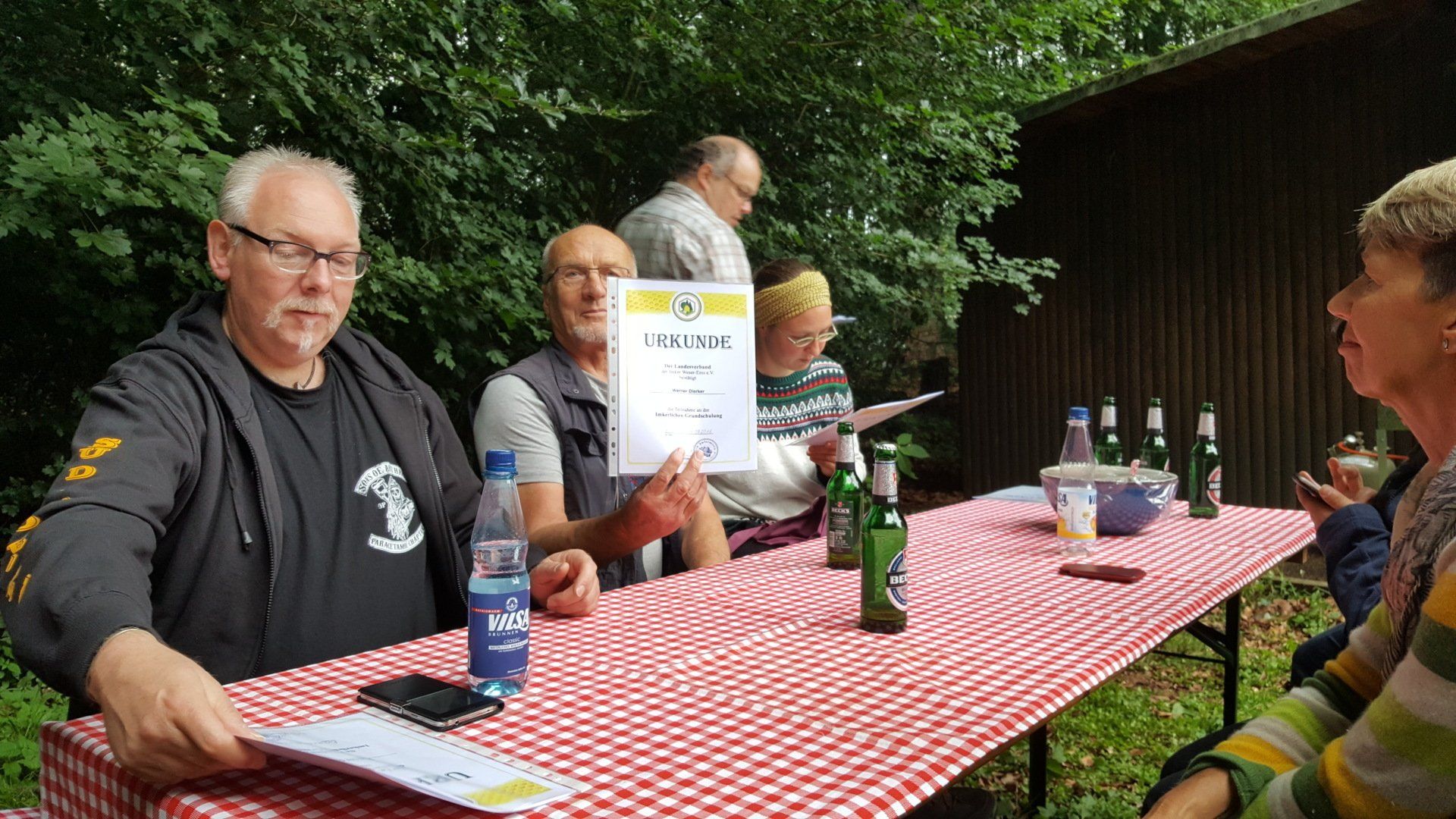Themenbereich I - J

Imago: The adult, sexually mature bee is called the imago. Only the Imago is able to fly. The other larval stages are not yet.
Imker: hält Bienen in Magazinbeuten, Bienenkisten und/oder im Bienenkorb, während der Zeidler ausschließlich mit Wildbienen arbeitet. Einige Imker betreiben nebenher auch eine Bienenzucht.
Beekeeping as a hobby or as a full-time job is always varied and diverse. Beekeeping is a very nature-loving activity. The honey bee is a farm animal, but certainly not a pet. Even under beekeeping care, she lives in and from nature. The beekeeping year with its different tasks follows the bee year and both are of course closely linked to the seasons. The beekeeper must know the environment in which their own bees live. Which costume is currently in bloom? What kind of weather do bees currently have to brave? Is it too cold Or too dry?
Beekeeping suit: the beekeeper wears a protective suit at work, it consists of a light-colored jacket and trousers with close-fitting cuffs. He also wears a white hat with a veil and beekeeper gloves with gauntlets. Some beekeepers work with meek bees and therefore often leave out gloves and veils. But that doesn't always work. If the costume does not have flowers, these bees are also often aggressive and attack the beekeeper.
Beekeeping: is an elaborate hobby or a full-time job for the professional beekeeper. A prerequisite for this is always a close connection with nature. The beekeeper has to be able to observe closely and know which head is in bloom. He must be able to assess the temperatures in order to protect the beehive if necessary. He has to fight diseases and ultimately make the honey. The beekeeper needs to know about the size, health and nutritional status of his colony at all times.
Beekeeper pipe: emits a herbal smoke that soothes the bees. Today, however, the beekeeper mostly uses a smoker
Imme: Früher wurden Bienen auch als Immen bezeichnet. Heute wird der Begriff nur noch in der Biologie für die Taillenwespe verwendet. „Immen“ stammt aus dem alemannischen für „Immle“– und bedeutet „Fleißiges Insekt."
Imported honey: not only often contain impurities. Genetically modified pollen was also found in him. In addition, imported honey has often been heated to a high temperature to make it easier to fill. You can recognize heat-damaged honeys, for example, by the fact that they do not crystallize out even after several weeks. German honeys that have been produced in accordance with the Honey Ordinance are always quality honeys that are produced with the utmost care.
Ingredients honey: Ingredients of honey
Inhibins: Active ingredients that prevent the growth of germs are known as inhibins. The inhibins contained in honey are the plant pigments, the flavonoids and the hydrogen peroxide.
Insect: Bees are insects. One recognizes insects by their body division. The head, thorax and abdomen are clearly separated from one another by constrictions (waist).
Intine: Die innere Wand, die den Pollen umgibt, ist die Intine. Als Exine wird die zweite Wand, die äußere, bezeichnet. Beide haben eine Schutzfunktion. Sie schützen das pflanzliche Erbgut des Pollens beim Transport.
Invertase: is a digestive enzyme that can be found in honey. It is produced when sugar is processed into fructose and glucose.
Isomaltose: The hemolymph of bees contains isomaltose, a type of sugar. It is similar to the glucose content in human blood.
Color of the year: For various reasons, especially to determine the age and the quick identification in the beehive, beekeepers occasionally mark their young queens with a glued-on opalith color plate (also numbered), drawing paint or pencil on the back armor. This marking gives information about the age of the queen. There are also five annual colors: white, yellow, red, green and blue. They are used alternately. After red in 2013, it is the turn of green in 2014, then blue in 2015, etc. The annual colors are internationally uniform and repeat themselves every five years in the same order, starting with the color white. The queen is marked by briefly removing it from the beehive and locking it in a holding device. With a flask coated with cotton wool, the space for the queen is reduced and she is thus held in the narrow opening at the top of the marking apparatus. So the beekeeper can label the insect and after a short drying process let it back into the colony. Commercially available plates sometimes contain tiny printed numbers. A non-toxic glue is used to fix it
Jungvolk: Das Bienenvolk wird im ersten Jahr auch als Jungvolk bezeichnet.
Juvenil hormone: is a typical insect hormone. It controls the development of insects. Before each molt, the production of the hormone is throttled and finally stopped completely. In the adult bee, the juvenile hormone controls the development of the sexual organs. Depending on the concentration of the hormone in the hemolymph, the age of a worker bee can also be determined.





